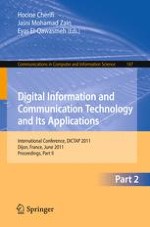This two-volume set CCIS 166 and 167 constitutes the refereed proceedings of the International Conference on Digital Information and Communication Technology and its Applications, DICTAP 2011, held in Dijon, France, in June 2010. The 128 revised full papers presented in both volumes were carefully reviewed and selected from 330 submissions. The papers are organized in topical sections on Web applications; image processing; visual interfaces and user experience; network security; ad hoc network; cloud computing; Data Compression; Software Engineering; Networking and Mobiles; Distributed and Parallel processing; social networks; ontology; algorithms; multimedia; e-learning; interactive environments and emergent technologies for e-learning; signal processing; information and data management.
